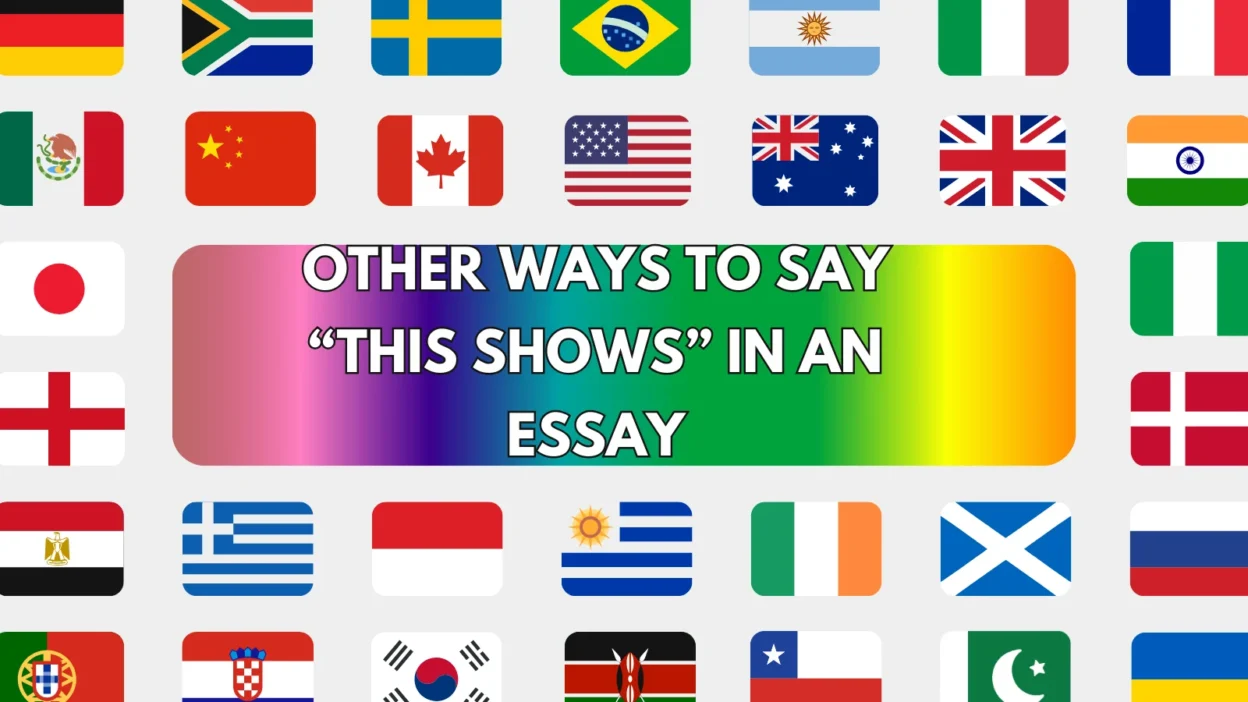In essay writing and academic analysis, many students often rely on the phrase “this shows” to explain ideas or link evidence to arguments. While it’s clear and functional, using it repeatedly can make your writing sound dull or mechanical. If you’ve ever wondered what to say instead of “this shows” or searched for different ways to say “this shows in an essay”, you’re not alone.
There are other words for “this shows” and countless alternatives to “this shows” that make your writing more persuasive and polished. Knowing how to say “this shows” in a different way or choosing another phrase for “this shows” helps you express analysis with variety and precision.
Whether you’re drafting a formal paper or writing a literary response, understanding other ways to say “this shows that”, synonyms for “this shows in an essay”, or even better words for “this shows” will elevate your academic tone. In short, finding another way to say “this shows” makes your arguments stronger, your essays smoother, and your writing style more professional.
Here are 25 refined alternatives to “this shows”, perfect for essays, critical analyses, and formal academic writing.
1. This Demonstrates
Meaning:
Indicates that something clearly proves or illustrates a point.
Detailed Explanation:
A slightly more formal alternative, commonly used in academic writing.
Scenario Example:
This demonstrates the author’s intent to critique social norms.
Best Use:
Essays, research papers, analytical writing.
Tone:
Formal, clear.
2. This Illustrates
Meaning:
Shows something clearly with examples or evidence.
Detailed Explanation:
Great for connecting ideas to evidence visually or conceptually.
Scenario Example:
This illustrates the growing tension between the characters.
Best Use:
Literature reviews, visual analysis.
Tone:
Explanatory, academic.
3. This Highlights
Meaning:
Draws attention to something important.
Detailed Explanation:
Emphasizes significance or focus on a specific aspect.
Scenario Example:
This highlights the importance of environmental awareness in the text.
Best Use:
Analytical writing, persuasive essays.
Tone:
Focused, insightful.
4. This Indicates
Meaning:
Suggests or points toward a conclusion or idea.
Detailed Explanation:
Useful for interpreting data, behavior, or implications.
Scenario Example:
This indicates a shift in the protagonist’s motivations.
Best Use:
Data analysis, argument development.
Tone:
Neutral, informative.
5. This Suggests
Meaning:
Implies a deeper meaning or interpretation.
Detailed Explanation:
Often used when making an inference or educated guess.
Scenario Example:
This suggests that power dynamics are central to the conflict.
Best Use:
Critical essays, thematic analysis.
Tone:
Analytical, speculative.
6. This Reflects
Meaning:
Reveals or mirrors an idea or value.
Detailed Explanation:
Useful for discussing broader social, cultural, or psychological themes.
Scenario Example:
This reflects society’s obsession with perfection.
Best Use:
Sociological essays, character analysis.
Tone:
Thoughtful, deep.
7. This Reveals
Meaning:
Uncovers or makes something clear that was hidden or subtle.
Detailed Explanation:
Effective when discussing deeper meanings or underlying messages.
Scenario Example:
This reveals the author’s critical stance on consumerism.
Best Use:
Literary analysis, film critiques.
Tone:
Insightful, revealing.
8. This Exemplifies
Meaning:
Provides a clear example of a concept or idea.
Detailed Explanation:
Academic and precise, ideal when linking theory to evidence.
Scenario Example:
This exemplifies the struggle between individuality and conformity.
Best Use:
Philosophical writing, case studies.
Tone:
Formal, academic.
9. This Underscores
Meaning:
Emphasizes or reinforces a point.
Detailed Explanation:
A strong way to add emphasis in arguments or conclusions.
Scenario Example:
This underscores the urgency of climate action.
Best Use:
Persuasive essays, impactful conclusions.
Tone:
Bold, assertive.
10. This Conveys
Meaning:
Communicates a message or emotion.
Detailed Explanation:
Often used in analyzing tone, mood, or symbolism.
Scenario Example:
This conveys a sense of isolation in the protagonist.
Best Use:
Literature and film essays.
Tone:
Expressive, analytical.
11. This Portrays
Meaning:
Shows something in a particular way or light.
Detailed Explanation:
Useful in describing how an author represents ideas or characters.
Scenario Example:
This portrays the king as both powerful and vulnerable.
Best Use:
Character analysis, historical context.
Tone:
Descriptive, interpretive.
12. This Depicts
Meaning:
Provides a detailed picture or representation.
Detailed Explanation:
More visual and vivid, especially useful in descriptive analysis.
Scenario Example:
This depicts a grim reality of war.
Best Use:
Literature, art, or history essays.
Tone:
Visual, analytical.
13. This Affirms
Meaning:
Confirms or supports a previously stated point.
Detailed Explanation:
Best when reinforcing a conclusion or previously made claim.
Scenario Example:
This affirms the theory that poverty is structurally maintained.
Best Use:
Research writing, debates.
Tone:
Confident, scholarly.
14. This Establishes
Meaning:
Proves or creates a firm basis for something.
Detailed Explanation:
Good for early argument development in essays.
Scenario Example:
This establishes the foundation for the author’s argument.
Best Use:
Introductions, supporting evidence.
Tone:
Structured, academic.
15. This Clarifies
Meaning:
Makes a concept or idea easier to understand.
Detailed Explanation:
Useful when explaining abstract or complex points.
Scenario Example:
This clarifies the relationship between the two characters.
Best Use:
Expository essays, concept explanations.
Tone:
Clear, supportive.
16. This Supports the Idea That
Meaning:
Provides evidence in favor of a particular idea.
Detailed Explanation:
Useful in building structured arguments.
Scenario Example:
This supports the idea that injustice is a central theme in the novel.
Best Use:
Argumentative essays, debates.
Tone:
Logical, firm.
17. This Aligns With
Meaning:
Agrees or is consistent with another idea or source.
Detailed Explanation:
Ideal when comparing sources or supporting arguments.
Scenario Example:
This aligns with the author’s earlier claim about identity.
Best Use:
Comparative essays, scholarly analysis.
Tone:
Harmonious, analytical.
18. This Echoes
Meaning:
Repeats or mirrors a previous point or theme.
Detailed Explanation:
Effective in showing connections across a text or multiple texts.
Scenario Example:
This echoes the motif of freedom throughout the novel.
Best Use:
Thematic essays, literary comparisons.
Tone:
Elegant, literary.
19. This Emphasizes
Meaning:
Stresses the importance of an idea.
Detailed Explanation:
Adds weight or significance to key points.
Scenario Example:
This emphasizes the need for reform.
Best Use:
Persuasive or argumentative essays.
Tone:
Strong, focused.
20. This Represents
Meaning:
Stands for or symbolizes something.
Detailed Explanation:
Ideal for symbolic or metaphorical analysis.
Scenario Example:
This represents the inner conflict faced by the character.
Best Use:
Literary or cultural studies.
Tone:
Interpretive, thoughtful.
21. This Exemplifies the Notion That
Meaning:
Acts as a clear example of a broader idea.
Detailed Explanation:
Formal and ideal for connecting evidence to abstract concepts.
Scenario Example:
This exemplifies the notion that power corrupts.
Best Use:
Academic writing, theory application.
Tone:
Formal, illustrative.
22. This Provides Evidence That
Meaning:
Supplies proof or support for a claim.
Detailed Explanation:
Great for introducing supporting evidence.
Scenario Example:
This provides evidence that early education shapes future behavior.
Best Use:
Scientific or research-based essays.
Tone:
Credible, formal.
23. This Captures
Meaning:
Effectively expresses or records something complex.
Detailed Explanation:
Used when something conveys the full essence of an idea or emotion.
Scenario Example:
This captures the emotional toll of poverty.
Best Use:
Literary or creative analysis.
Tone:
Descriptive, poignant.
24. This Reinforces
Meaning:
Strengthens a previously stated point.
Detailed Explanation:
Used to show repeated or additional support for an argument.
Scenario Example:
This reinforces the argument that equality remains elusive.
Best Use:
Debate essays, persuasive writing.
Tone:
Strong, logical.
25. This Validates
Meaning:
Confirms the truth or legitimacy of an idea.
Detailed Explanation:
Excellent for showing that evidence confirms your point.
Scenario Example:
This validates the importance of psychological safety in workplaces.
Best Use:
Research-based or social science essays.
Tone:
Authoritative, confirming.
Conclusion
In academic and essay writing, variety is key. Instead of relying solely on “this shows,” using these 25 intelligent alternatives will help you sound more articulate, persuasive, and professional.
Each alternative carries its own tone and strength, allowing you to match your language to your ideas more effectively.




